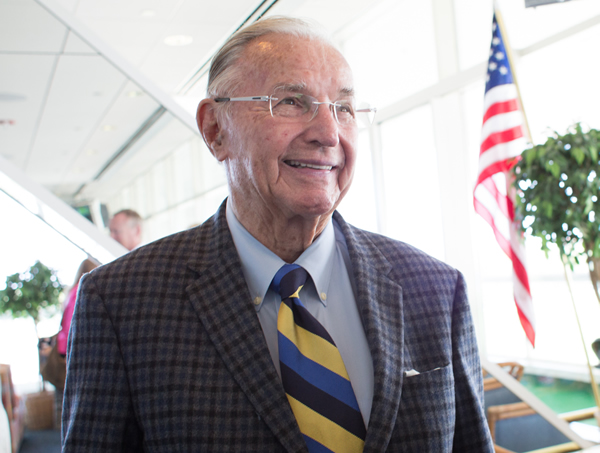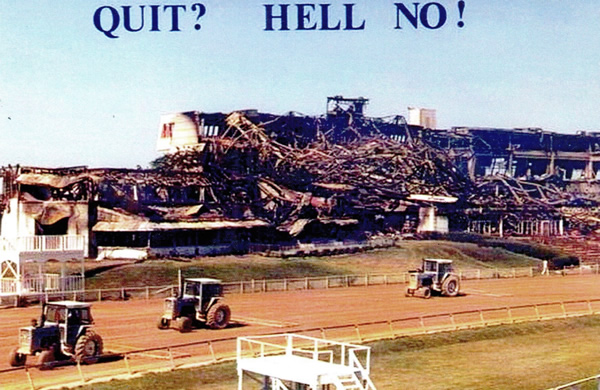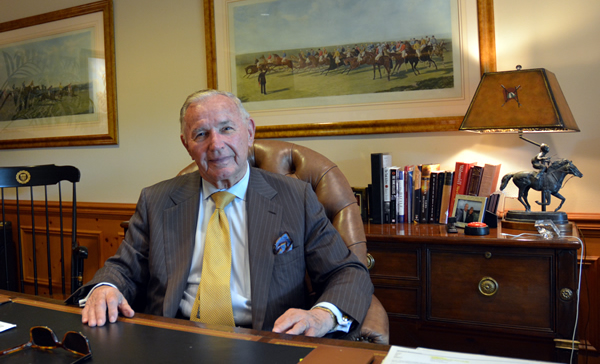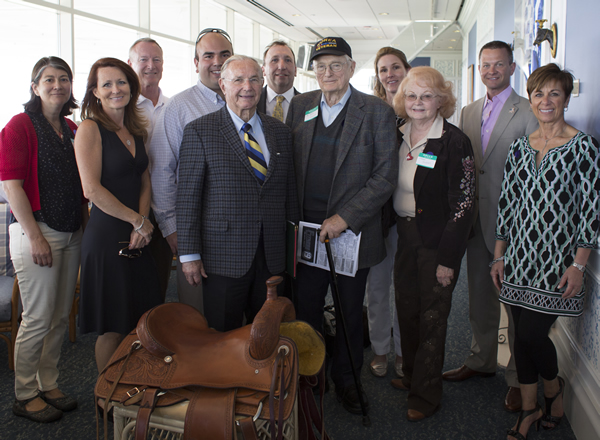Quintessential America
One in a Million
The Arlington Million: A World-Class Venue in Barrington’s Backyard

A Triple Crown Day! Richard Duchossois at Arlington International on June 6, 2015 before the televised running of the Belmont Stakes in Elmont, N.Y. (Photo: Matthew Bowie)
What would you bet that a world-class horse racing event—the Arlington Million—could go on after its huge trackside facility in Northern Illinois burnt completely to the ground 30 years ago—just 24 days before the Million’s scheduled post time? Arlington International burned uncontrollably—one of Illinois’ greatest 20th century fires and so extensive that fire departments from 21 communities could not put it out.
It was 1985 and the innovative Million was just a few years old. In fact, Arlington International originated the first million dollar purse in the world in 1981—and this bold stakes move made the already significant racetrack world-famous, kicking up tourism and supporting the infrastructure of the horse racing industry.
Arlington Park’s Chairman, Richard Duchossois, made what must have been one of the biggest bets of his life after the fire. The race will go on. For a man who professes not to be a race-tracker—“We’re not race track people,” he says more than once. His devotion to keeping Arlington Park and the horse racing industry intact began with an unexpected purchase of 85 percent of the operation just two years before the fire. He had lost his beloved wife, Beverly, and his life had changed. He decided to visit the Kentucky Derby—something he had never done before. While visiting with businessmen at the race track, he was invited to become part of a syndicate to buy Arlington Park. When the papers were ready to be signed, Duchossois was the only one who could furnish the funds, so he became the majority owner.

Richard Duchossois had this postcard in his top desk drawer and shared it with QB.
A few years later came the fire. “It never dawned on me that we would cancel [the Million]. We made a commitment—there were Europeans who had already shipped their horses, hotels were booked, and I don’t like excuses,” said Duchossois. “I didn’t know it couldn’t be done,” he said of the facility’s rebuild. This decorated World War II veteran who fought in Normandy would not take “no” for an answer. There was too much as stake.
A race against time
“All of us worked 16 to 18 hours a day,” Duchossois said. “We all helped each other. We had the right people doing the right jobs.” The rebuild operation included an airplane on-call 20 hours per day at Palwaukee airport. Duchossois said he could get home to his farm in Barrington Hills and after a short amount of sleep, return to carry on the next two consecutive shifts day after day.
Fortunately, no people or horses were lost in the historic blaze. Duchossois knew that Arlington International was an economic engine in Illinois and he felt obligated to rebuild it—asking Arlington Heights municipal leaders to not raise taxes, even though the new facility would be larger. They obliged.
After the fire, Duchossois led visits to five or six other well-known race tracks around the United States and talked with customers to learn what they didn’t like about those facilities. He listened, and rebuilt Arlington International to a new set of standards—with families, women, and safety in mind. That meant adding 50 percent more washrooms for women, a picnic grounds for families, sparkling clean facilities, and seating area views not blocked by posts. “There is something for everyone,” Duchossois says of Arlington International. Each level of the facility runs the gamut from suit and tie, to shorts and T-shirts. The park’s layout and multiple levels offer something for everyone.
The winner’s circle
One of the Chicago area’s greatest fires was interpreted by Duchossois as a major competitor. Perhaps this is what drove the highly competitive man to rebuild what some say is America’s finest horse racing track. Yet the current drain on horse racing in Illinois due to the increases in gaming—which is now distressing and potentially threatening the industry—is seen by Duchossois as its greatest competitor. Arlington International and Hawthorn Race Course are teaming up to strengthen their positions, trying to keep the purses up.

A visit with Richard Duchossois in his office at Arlington International on August 7, 2015.
(Photo: Lisa Stamos)

On June 6, 2015, Richard Duchossois visits with staff and friends of BraveHearts at its fundraiser. BraveHearts is a therapeutic and educational equine-assisted therapy organization.
To learn more, visit www.braveheartsriding.org. (Photo: Matthew Bowie)
And while Duchossois says he is not into being a “race tracker,” his commitment to saving Arlington International then, after the fire, and now, speaks to his highly disciplined character—by doing what’s right for those invested, and the layers of smaller businesses that depend on the horse racing industry.
For a man who entered the business by accident, as he says of his investment in Arlington International in the 1980s—his ongoing commitment to offer family friendly experiences at the races is your invitation to spend the day at Arlington International to see what it’s all about.
Get in on the fun at the Arlington Million this coming weekend. For more info, visit Arlington International.
Lisa Stamos is the publisher of Quintessential Barrington.
